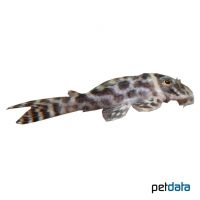Pleco L400 (Hypancistrus sp. 'L400')
| Pleco L400 Hypancistrus sp. 'L400' | |
|---|---|
| Name | Pleco L400 |
| Name Lat. | Hypancistrus sp. 'L400' |
| Family | Suckermouth Armoured Catfishes |
| Family lat. | Loricariidae |
| Order | Catfishes |
| Order lat. | Siluriformes |
| Origin | Brazil |
| Habitat | Streams |
| Diet | Omnivore, soft wood |
| pH | 5.5-7.5 |
| Behavior | Nocturnal, peaceful |
| Keeping | Individual, group |
| Care Level | Moderate |
| Reproduction | Cave spawner |
| Breeding | Difficult |
| Life Span | 5-8 years |
| Protection | No |
| Metric Units | |
| Size | 10-12 cm |
| Temperature | 24-28 °C |
| Hardness | 2-20 °dH |
| Aquarium | ~ 150 l |
| US Units | |
| Size | 4"-5" |
| Temperature | 75-82 °F |
| Hardness | 36-356 ppm |
| Aquarium | ~ 40 gal |
Distribution and habitat
The range of the L400 Great Ocelot Hare Catfish is the Rio Xingu river system near Belo Monte, Brazil. They live in oxygen-rich, fast-flowing, small rivers and streams, often with overhanging riparian vegetation, where they stay in shallow water with sandy bottoms, roots and boulders.
Maintenance
The aquarium should have robust planting with numerous caves made of stones and roots that provide hiding places. A sandy substrate with round gravel, slightly shaded light and oxygen-rich water with a moderate current is ideal.
No ammonia, ammonium or nitrite should be detectable, and the nitrate level should not exceed 100 mg/l. To ensure the water quality and oxygen content, a filter and heater adapted to the aquarium size is required, as well as lighting for the species-appropriate day-night rhythm of the animals.
Diet
They prefer animal food, except for juveniles, which feed mainly on vegetable food. For a balanced diet, feed once a day with a high-quality dry food for loricariid catfish (granules, pellets, chips, tablets), supplemented with algae leaves, soft wood and fresh vegetables, such as zucchini, broccoli, bruised peas, scalded spinach, as well as zoopankton, cyclops, daphnia, artemia, mosquito larvae, shrimp and mussel meat (live or frozen)
Only feed as much as will be eaten within a few minutes, excluding plant foods. Regular and varied feeding promotes health and increases resistance.
Behaviour and compatibility
These peaceful and lively fish are crepuscular to nocturnal and should be maintained in a group of 4-5 individuals. A socialization with other peaceful fish, such as barbs and tetras is well possible.
Basically, only compatible fish species with similar demands on water conditions and water temperature should be socialized.
Sex dimorphism
Males have a thickened first pectoral fin ray and more and longer odontodes (pointed skin teeth) than females.
Reproduction and breeding
They spawn in caves. The clutch is cared for by the male. The larvae hatch after about 7 days and swim free after another 6-7 days.
The fry must be fed several times a day with special rearing food. In community tanks breeding is hardly possible, because the fry are easy prey.
Important
Their pattern is very variable and can be confused with Hypancistrus sp. L173 or L236. They require warmth and should not be kept permanently below 26 °C.
Aquarium plants do not serve them as food and are hardly nibbled or eaten.
When catching them, use as fine-meshed nets as possible to prevent the hard rays of the pectoral fins or the skin teeth (odontodes) from getting caught on the bone plates, which can cause painful puncture wounds when touched.
The well-being of the fish should be checked regularly. Temperature should be checked daily, pH, hardness and nitrate levels at least every 14 days. Regular partial water changes are recommended, even when contaminant levels have not yet reached the upper limit. Sudden changes in water quality should be avoided. Newly introduced fish must be accustomed slowly to the water in the aquarium.
Further literature can be found in your pet store.
References
Text: Werner Winter; Image: petdata
Source: BMELV (1998): Tierschutzgutachten - Haltung von Zierfischen (Süßwasser); ENGELMANN (2005): Zootierhaltung - Tiere in menschlicher Obhut: Fische, Verlag Harri Deutsch; SCHMIDT, WERNER, LECHNER (2005): MiniAtlas L-Welse, Bede Verlag
- Gemäß § 21 Abs. 5 Tierschutzgesetz idgF
